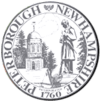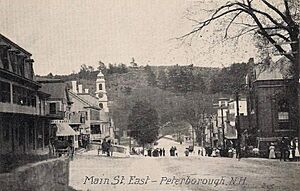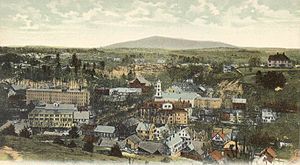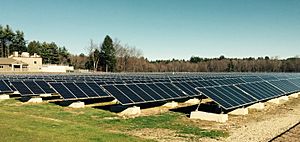Peterborough, New Hampshire facts for kids
Quick facts for kids
Peterborough, New Hampshire
|
||
|---|---|---|
|
Town
|
||
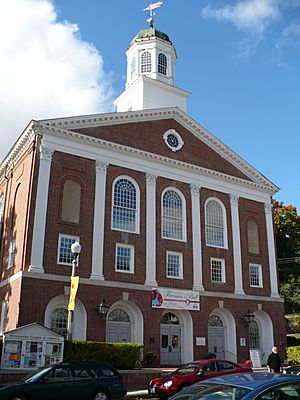
Town House, built in 1918
|
||
|
||
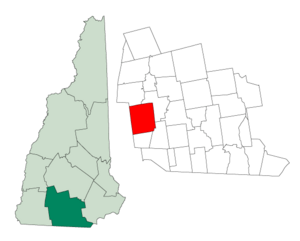
Location in Hillsborough County, New Hampshire
|
||
| Country | United States | |
| State | New Hampshire | |
| County | Hillsborough | |
| Incorporated | 1760 | |
| Villages | Peterborough Happy Valley Noone North Village West Peterborough |
|
| Area | ||
| • Total | 38.43 sq mi (99.53 km2) | |
| • Land | 38.02 sq mi (98.47 km2) | |
| • Water | 0.41 sq mi (1.06 km2) 1.06% | |
| Elevation | 718 ft (219 m) | |
| Population
(2020)
|
||
| • Total | 6,418 | |
| • Density | 169/sq mi (65.2/km2) | |
| Time zone | UTC−5 (Eastern) | |
| • Summer (DST) | UTC−4 (Eastern) | |
| ZIP Code |
03458
|
|
| Area code(s) | 603 | |
| FIPS code | 33-60580 | |
| GNIS feature ID | 0873697 | |
Peterborough is a small town in Hillsborough County, New Hampshire, United States. In 2020, about 6,418 people lived there. The main part of town, called a census-designated place (CDP), had 3,090 residents in 2020. It is located along the Contoocook River, where U.S. Route 202 and New Hampshire Route 101 meet. Peterborough is about 38 miles (61 km) west of Manchester and 72 miles (116 km) northwest of Boston.
Contents
History of Peterborough
When Was Peterborough Founded?
Peterborough was first granted by Massachusetts in 1737. People started settling there permanently in 1749. The town faced several attacks during the French and Indian War. However, by 1759, about fifty families had made it their home.
Peterborough officially became a town on January 17, 1760. Governor Benning Wentworth named it after Lieutenant Peter Prescott, who was a land speculator from Concord, Massachusetts.
How Did Peterborough Grow?
The Contoocook River and Nubanusit Brook had many spots for watermills. This helped Peterborough become a busy mill town. In 1810, the first factory for making cotton was built. By 1859, with 2,222 people living there, the town had five cotton factories and a woolen mill.
Other businesses included two paper mills, an iron foundry, and a machine shop. There was also a carriage factory, a basket maker, and a boot and shoe factory. The town also had seven sawmills and three gristmills.
Important Cultural Firsts
The Reverend Abiel Abbot became a minister in Peterborough in 1827. He started the town's first prep school. He also founded the Monadnock Summer Lyceum and the first free public library in the United States, all in Peterborough.
Peterborough opened the first public library in the U.S. that was supported by taxes in 1833. This success led the New Hampshire State Legislature to pass a law in 1849. This law allowed other towns to raise money for their own libraries. The first library was in the town's general store and post office. The postmaster was also the librarian. In 1873, the library moved to the town hall.
Other early cultural places included Mariarden, a summer theater. Famous actors like Paul Robeson and Bette Davis performed there.
Music and Magazines in Peterborough
In 1976, Widdie and Jonathon Hall started the Peterborough Folkway. It quickly became a popular place for folk musicians on the East Coast. It was popular for twenty years. Musicians like Tom Paxton and Mary Chapin Carpenter often performed there.
In the 1980s, Peterborough became known for publishing magazines. Thanks to publisher Wayne Green, over 100 magazines were published there. Most of these were about computers and technology, like Byte magazine.
Environmental Efforts
Peterborough began focusing on environmental protection in the 1990s. Its Earth Day USA office helped support Earth Day events around the world.
Geography and Nature
Where is Peterborough Located?
Peterborough covers about 99.5 square kilometers (38.4 sq mi). Most of this area is land (98.5 sq km or 38.0 sq mi), and a small part is water (1.1 sq km or 0.4 sq mi). The town gets its water from the Contoocook River and its smaller streams, Nubanusit Brook and Otter Brook. All the water in town flows into the Merrimack River.
The highest point in Peterborough, and in Hillsborough County, is the top of South Pack Monadnock. It is 2,290 feet (698 m) above sea level. This peak is located in Miller State Park.
Outdoor Activities
Peterborough is home to the Edward MacDowell Dam and Lake recreation area. Here, visitors can walk across the dam and enjoy many outdoor activities. These include hiking, cross-country skiing, swimming, and boating. There are also places for picnics, Frisbee golf, and horseshoes. Many of these activities are easy for people with disabilities to access.
The town has many outdoor spaces. These include hiking trails, places to see wild flowers, and areas for cross-country skiing. You can also go kayaking, cycling, and enjoy small lakes for swimming, sailing, fishing, and ice-skating. It's a great spot for bird-watching, especially for raptors during their autumn migration.
People of Peterborough
Population Changes Over Time
Peterborough has grown steadily over the years. In 1790, there were 861 people. By 1950, the population was 2,556. The most recent census in 2020 showed 6,418 residents.
| Historical population | |||
|---|---|---|---|
| Census | Pop. | %± | |
| 1790 | 861 | — | |
| 1800 | 1,333 | 54.8% | |
| 1810 | 1,537 | 15.3% | |
| 1820 | 1,500 | −2.4% | |
| 1830 | 1,984 | 32.3% | |
| 1840 | 2,163 | 9.0% | |
| 1850 | 2,222 | 2.7% | |
| 1860 | 2,265 | 1.9% | |
| 1870 | 2,236 | −1.3% | |
| 1880 | 2,206 | −1.3% | |
| 1890 | 2,507 | 13.6% | |
| 1900 | 2,527 | 0.8% | |
| 1910 | 2,277 | −9.9% | |
| 1920 | 2,615 | 14.8% | |
| 1930 | 2,521 | −3.6% | |
| 1940 | 2,470 | −2.0% | |
| 1950 | 2,556 | 3.5% | |
| 1960 | 2,963 | 15.9% | |
| 1970 | 3,807 | 28.5% | |
| 1980 | 4,895 | 28.6% | |
| 1990 | 5,239 | 7.0% | |
| 2000 | 5,883 | 12.3% | |
| 2010 | 6,284 | 6.8% | |
| 2020 | 6,418 | 2.1% | |
| U.S. Decennial Census | |||
Who Lives in Peterborough?
In 2010, there were 6,284 people living in Peterborough. Most residents were White (96.1%). About 1.8% were Asian, and 0.7% were Black or African American. A small number of people were Native American or Pacific Islander. About 1.4% of the population was Hispanic or Latino.
The town had 2,713 households. About 28.1% of these households had children under 18. The average household size was 2.24 people. The average family size was 2.85 people.
The median age in Peterborough was 46.6 years. About 21.5% of the population was under 18. About 22.0% were 65 years or older.
Economy and Jobs
What Businesses are in Peterborough?
Peterborough is a place where many new businesses start. Companies like New Hampshire Ball Bearing and Pure Flow began here. Many people in Peterborough work from home or run their own businesses.
Brookstone, a well-known retail company, also started in Peterborough. Other local businesses include Toadstool Bookstores and Froling Energy.
Tourism in Peterborough
Like other parts of New Hampshire, tourism is a big industry in Peterborough. Many visitors come to enjoy the town's cultural attractions and natural beauty.
Arts and Culture Attractions
Peterborough has many cultural places to visit. These include the Monadnock Center for History and Culture. The Sharon Arts Center has galleries for art and crafts. You can also see plays at the Peterborough Players theatre or movies at the Peterborough Community Theater cinema.
Other attractions include Monadnock Music concerts and the Monadnock Summer Lyceum. The MAXT Makerspace is a place for creative projects. The Mariposa Children's Museum is fun for younger kids. Peterborough also hosts "First Saturday" contradances at the Town Hall.
Arts and Culture
The MacDowell Colony
Many artists come to Peterborough as fellows at the MacDowell Colony. This is a creative retreat in a wooded area. It gives grants to about 300 artists each year.
Town Events
Peterborough celebrates "First Friday" every month. This event includes presentations by MacDowell artists, gallery openings, and live music. The Peterborough Diner, a historic railway lunch car, is a popular spot in the town square.
The town hosts several annual events. These include the Snow Ball in January and Children and the Arts Day in May. The Thing in the Spring is a music festival in June. Greenerborough is a summer festival that promotes the town's commitment to sustainability.
Historical and Performing Arts
The Moses Cheney house in Peterborough was a stop on the Underground Railroad in the mid-1800s. This was a network that helped enslaved people find freedom.
The Peterborough Players have been performing plays since 1933. New Hampshire's oldest active state militia unit, the Lafayette Artillery Company, was founded here in 1804. The Mariposa Museum has a collection of marionettes and puppets.
Education in Peterborough
Public Schools
Peterborough's public schools are part of the Contoocook Valley school district (SAU 1). This district has 11 schools and one applied technology center.
- Contoocook Valley Regional High School: Built in 1970, it serves about 700 students.
- South Meadow School: Founded in 1989, it serves about 400 students.
- Peterborough Elementary School (PES): This school serves about 250 students.
Private Schools and Institutes
While there are many private kindergartens and preschools, The Well School is the only Pre-8 school in town. Founded in 1967, it serves about 160 students on a large rural campus. The Clay Mathematics Institute, which supports math research, is also located here.
Infrastructure and Environment
Peterborough aims to get 100 percent of its energy from sustainable sources. The town built the largest solar facility in New Hampshire next to its wastewater treatment plant.
Notable People from Peterborough
Many interesting people have connections to Peterborough.
- Reverend Abiel Abbot (1765–1859), a minister and educator who founded the first free library.
- Charles Bass (born 1952), a US congressman.
- Robert P. Bass (1873–1960), a former Governor of New Hampshire.
- Moses Cheney (1793–1875), an abolitionist and legislator.
- Person Colby Cheney (1828–1901), a US senator and former Governor of New Hampshire.
- Landon T. Clay (1926–2017), a businessman and founder of the Clay Mathematics Institute.
- Wayne Green (1922–2013), a famous publisher of computer magazines.
- Sam Huntington (born 1982), an actor.
- Beth Krommes (born 1956), an illustrator who won the Caldecott Medal.
- Edward MacDowell (1860–1908), a well-known composer.
- Marian MacDowell (1857–1956), who founded the MacDowell Colony.
- Bob McQuillen (1923–2014), a teacher and musician known for contra dance tunes.
- James Miller (1776–1851), a US congressman and general.
- George Swinnerton Parker (1866–1952), who created the Parker Brothers game company. His house in Peterborough inspired the game Clue.
- Walter R. Peterson, Jr. (1922–2011), a former Governor of New Hampshire.
- Jeremiah Smith (1759–1842), a jurist and former Governor of New Hampshire.
- Elizabeth Marshall Thomas (born 1931), an author.
- Elizabeth Yates (1905–2001), an author who won the Newbury Medal.
Images for kids
See also
 In Spanish: Peterborough (Nuevo Hampshire) para niños
In Spanish: Peterborough (Nuevo Hampshire) para niños


